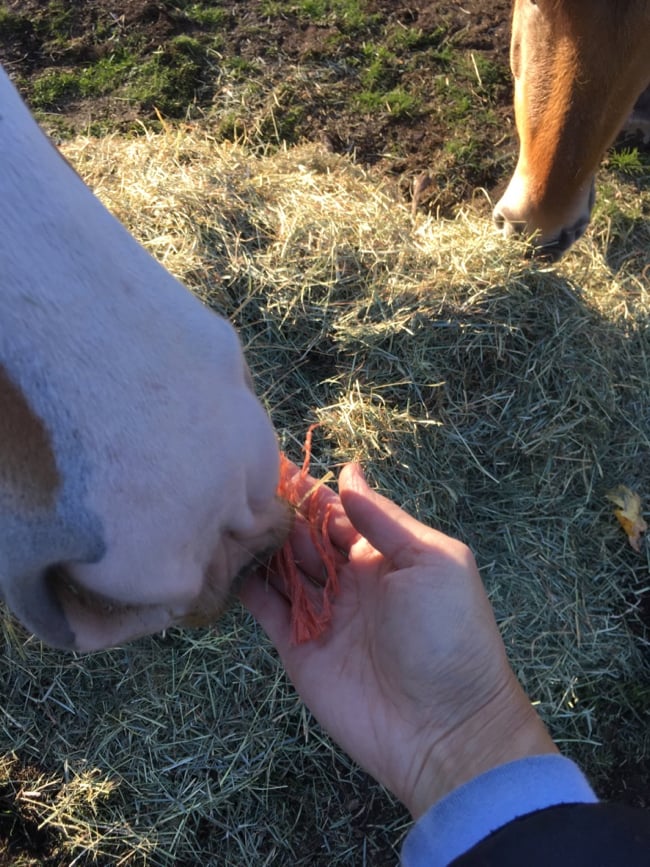I was going to send this privately to the two gals who help me out with my barn chores, but then I thought: We have a lot of newbies on this blog. People who have boarded their horse for a long time and are just getting ready to have their own place. Or, people who have always been drawn to horses and finally have the time, money, or given themselves permission to get their first horse. 🙂
I know I learn a lot from watching how other people do things, so I figured I might as well throw this up here for anyone who’s interested. These are my instructions for my barn help, of the most efficient way to receive hay deliveries out at our place:
1. Half an hour before the hay truck is due to arrive, close off the paddock (both gates), clear away all the manure, and lay a big tarp out flat in front of the hay barn. Because THIS is how much hay is going to result from 2 tons of hay bales tumbling off the truck onto the graveled paddock. Remember, whatever hay spills onto the gravel, you have to clean up:

Note: After the hay is stacked, ask the hay guy(s) to help you cover the hay stack with the other, regular tarp – it is much easier to do this with help! We have one tarp to cover the hay stack, and another tarp to cover the ground during deliveries.
2. After the hay truck leaves, sort through the hay on the tarp and remove all the bits of hay twine you see (these can cause colic if ingested). Then lift up each side of the tarp to shake the hay into the center:

3. Gather and twist the sides of the tarp together to form a sack so you can carry the hay out of the paddock and into the field. Do not drag the tarp on the gravel or it might tear:

4. When you reach the field gate, put the tarp sack down, open the chain, then push the gate outward as you walk into it with the sack. **Make sure you have closed the gate from the paddock to the road first!

AND make sure you have closed up the gate to the hay storage! We don’t want any horses gittin’ busy while you’re out in the field 🙂

5. Carry the tarp sack to the driest part of the field you can find, then shake the hay down gradually, so it rolls off one end of the tarp into a nice big pile – this way they will be able to eat more and waste less (if you spread it out, they will just walk all over it and not eat the stomped bits). Be sure to check again for bits of hay twine and remove:

6. Now shake the tarp free of any remaining bits and spread it out full-length on the driest ground you can find:

7. Fold the tarp in half, then in half again, then again, etc. until it is completely folded up. Just pick up a corner of the tarp and walk it over to the other corner – then go get the 2nd corner and walk it over to match:


8. After you’ve folded it nice and small, kneel on the tarp to squash out any air – this will help it stay folded in the tack room:

9. Now you get to go back and clean up any leftover hay on the gravel. Remember, we have to remove ALL organic matter from the gravel so it remains a good drainage surface and dry for their hooves through the winter:

10. If you forgot to ask the hay guy to help you cover the hay stack, then cover it with the regular hay stack tarp and weight it down with wooden pallets so it stays dry and doesn’t blow off.

And that’s it – now we can go back to the regular chore of just keeping those slow feeders filled!


Jini Patel Thompson is a natural health writer and Lazer Tapping instructor. She began riding at age 2 in Kenya, and got her first horse at age 8 in Alberta, and so continues a life-long journey and love affair with these amazing creatures.








What type off grate do you use? I use slow feeder hay nets but they bite through them in 6 weeks..
Cheryl from New Zealand
Hey Cheryl, I’ve been using a 2×2-inch steel grate. But my Belgian mare finds the holes too small and can beat up on them. So while they are all out of commission right now (seeing if I can find someone to weld them back together), I’m testing a 4×4″ grate and seeing how that works. Mine also tear through every hay net I’ve ever tried. I will say that MORE important than the size of grate, or the type of net, seems to be the sugar content of the hay I feed. Anything with an NSC higher than 9.5-10% turns them into rabid dogs that eat WAY more than they need – and damage the slow feeders to get to it. But if I keep the sugar lower than 10% NSC (non-structural carbohydrates) then everything works great and they are in great shape too.
Right now, I’ve been having difficulty getting hay with NSC in that range (drought raises sugar levels) and they all look pregnant and are eating 50-70% more hay than normal!!
I’m thinking of testing this 2×4-inch grate next:
https://www.edgewholesaledirect.com/welded-mesh-panels/2×4-Horse-Sheep-and-Goat-Panels-8ft-x-52-39.php